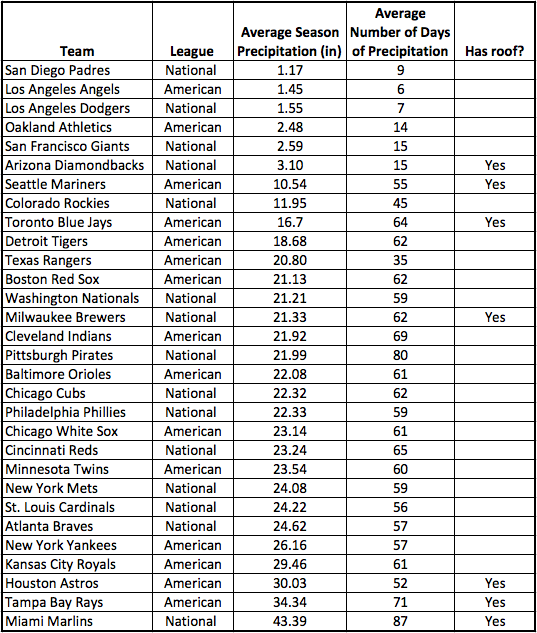The Precipitation Winners and Losers in Major League Baseball
Seattle’s rainy reputation is difficult to combat, especially among those that have never lived in the Pacific Northwest. The dry Washington summers are often overlooked. In that context, OWSC was pleased to have recently heard a “rumor” that during the regular baseball season, Seattle is one of the driest cities of those that have a Major League Baseball team. Statistics are part of baseball, so we decided to take a closer look at our specialty – weather statistics – to determine the validity of this rumor.
The total 1 April through 30 September 30-year (1981-2010) average precipitation and the average number of days with measurable precipitation (0.01” or greater) is shown for each MLB team location in Table 1. The records for the Toronto Blue Jays are for essentially the entire 20th century for the mean rainfall, and for the decade of the 1960s for the average number of days with measurable precipitation, but are apt to be representative of the present climate for that location. The Seattle Mariners only receive about 11” of precipitation, on average, during the season, which ranks as the 7th driest MLB location overall, and the 3rd driest in the American league. The top 5 driest are all of the California teams, and excluding those would rank Seattle second to only the Arizona Diamondbacks, who play in Phoenix. Most of the cities with MLB teams receive between 20 and 25” of precipitation during the season, which is double the normal amount that Seattle receives. In terms of the probability of measurable precipitation, Seattle is 10th lowest, but is more comparable to the majority of stadiums that have between 55 and 65 days with precipitation during the season. Many of the locations that have a similar number of days with rain receive a considerably greater amount of rain than Seattle. This is testament to the common occurrence of light rains in Seattle. For example, while Seattle and Houston have about the same number of rainy days during the six months considered here, a bit less than one-half of these days have rainfall greater than of equal to 0.10” in Seattle (Boeing Field), while about two-thirds of the rainy days in Houston meet or exceed this threshold.
Only seven of the MLB stadiums have retractable or stationary roofs, so how does this match with the precipitation climatology? The three teams with the rainiest season – Miami Marlins, Tampa Bay Rays, and Houston Astros – have stadiums with roofs and so indeed it is practical to be able to keep fans and the field dry. It is interesting that many of the stadiums that receive double the amount of precipitation as Seattle do not have roofs. The remaining three that do – Milwaukee Brewers, Toronto Blue Jays, and Arizona Diamondbacks – are more due to the temperatures, that is, keeping fans warm in Milwaukee and Toronto, and cool in Phoenix. So why does the Seattle Mariners stadium have a roof? To perpetuate stereotypes, of course! All kidding aside, it is the outlier among the rest of the group that has roofs, though it can be useful, especially early in the season.
This summary confirms that there is some truth to the rumor. Seattle is in the driest one-third of cities that have a MLB team, and the 3rd driest in the American League with regards to precipitation amounts. For frequency of precipitation, Seattle also ranks in the top one-third driest and the 5th less frequent in the American league (though admittedly, by very slim margins here). The next time someone comments on Seattle’s rain, you might just want to have these weather stats ready. The combined staff at OWSC has been to 9 different stadiums, and the home of the Seattle Mariners is the unanimous and completely unbiased favorite.
